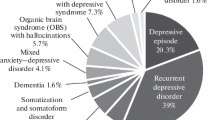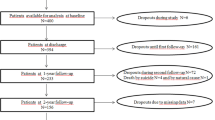Summary
A treatment experiment in a ward of a Swedish mental hospital is reported. Twenty-seven women aged 47 to 80 years, who had been in hospital between 12 and 53 years, and were functioning at a very low level, were observed for 22 months. The treatment consisted of conventional habit training, including sociotherapy and pharmacotherapy. The results of the treatment were systematically measured from records of personal hygiene and ratings on a set of scales. Improvement was statistically demonstrated. Patients tended to deteriorate when the head nurse changed. A correlation analysis of all the variables used showed that a low level of functioning (including poor personal hygiene), advanced stage of illness, long hospitalization, lack of contact with relatives, and low degree of mobilization were associated together. On the other hand, age was not correlated with these variables. According to a multiple regression analysis based on five representative variables, the inactivity-isolation syndrome was most associated with the criterion of improvement, whereas the hyperactivity-disintegration syndrome, scores on habit scales, and length of stay added little extra predicting power. The results are discussed in connection with previous studies of chronic schizophrenia.
Résumé
On rapporte ici une expérience thérapeutique faite dans une division d'un hôpital psychiatrique suédois. 27 femmes âgées de 47 à 80 ans, qui séjournaient à l'hôpital depuis 12 à 53 ans et très détériorées, ont été observées pendant 22 mois. Le traitement consistait en rééducation traditionnelle, ainsi qu'en sociothérapie et pharmacothérapie. Les résultats du traitement ont été systématiquement mesurés d'après l'amélioration de l'hygiène personnelle et les échelles de performances. Un progrès a été statistiquement démontré. Les patientes tendaient à régresser quand l'infirmière-chef changeait. Une analyse des corrélations entre toutes les variables utilisées a montré qu'une nette détérioration (incluant une hygiène personnelle pauvre), un stade avancé de la maladie, une longue hospitalisation, une absence de contact avec les proches et un faible degré de mobilisation, étaient des facteurs liés entre eux. D'autre part, le facteur âge n'était pas en relation avec ces variables. Selon une analyse de la régression multiple basée sur 5 variables représentatives, c'est le syndrome inactivitéisolement qui était le plus associé au critère de progrès, tandis que le syndrome hyperactivité-désintégration, les performances réalisées et la longueur du séjour n'étaient que peu significatifs. Les résultats sont discutés par rapport aux études antérieures faites sur la schizophrénie chronique.
Zusammenfassung
Es wird von einem Behandlungsexperiment auf einer Station einer psychiatrischen Klinik Schwedens berichtet. Man beobachtete über 2 Monate hinweg 27 Frauen im Alter zwischen 47 und 80 Jahren, deren Aufenthaltsdauer in der Klinik zwischen 12 und 54 Jahren lag, und die auf einem sehr niedrigen Niveau funktionierten. Die Behandlung bestand in einem Training von gebräuchlichen Verhaltensweisen, das Soziotherapie und Pharmakotherapie einschloß. Die Ergebnisse der Behandlung werden systematisch abgeschätzt auf Grund von Berichten über persönliche Hygiene und auf Grund von Einstufungen auf einer Serie von Skalen. Die Verbesserung wurde statistisch demonstriert. Die Patienten neigten zur Verschlechterung, wenn die Oberschwester wechselte. Eine Korrelationsanalyse aller verwendeten Variablen zeigte, daß niedriges Funktionsniveau (einschließlich schlechter persönlicher Hygiene), fortgeschrittenes Krankheitsstadium, lange Hospitalisierung, mangelnder Kontakt zu Verwandten und ein niedriger Aktivitätsgrad zusammen vorkommen. Andererseits korrelierte das Alter nicht mit diesen Variablen. Aus einer multiplen Regressionsanalyse, die auf fünf repräsentative Variablen gegründet war, folgt, daß das Inaktivitäts-Isolationssyndrom am meisten mit dem Kriterium der Besserung verbunden ist, während das Überaktivitäts-Desintegrationssyndrom, die Bewertung auf den Verhaltensskalen und die Länge der Aufenthalte wenig zusätzliche Vorhersagekraft ergaben. Die Ergebnisse werden in Verbindung mit früheren Untersuchungen über chronische Schizophrenie diskutiert.
Similar content being viewed by others
References
Arfwidsson, G. W.: Socioterapin vid S:t Lars sjukhus, Myrstacken Nr. 2. Mimeo (1965).
Deming, W. E.: Some theories of sampling. New York: John Wiley 1950
Galioni, E. F., F. H. Adams, andF. F. Tallman: Intensive treatment of back-ward patients -a controlled pilot study. Amer. J. Psychiat.109, 576 (1953).
Genberg, E.: Varians-och regressionsanalys. Norrköping: Genberg 1961.
Gerle, B.: Mentalsjuksvardens nuvarande resurser och informing. Statens offentliga utredningar38, 201. Stockholm (1959).
Gottfries, I.: Construction of rating scales for severely ill schizophrenic patients. Lund: Mimeo 1967.
Lienert, G.: Verteilungsfreie Methoden in der Biostatistik. Meisenheim am Glan: Anton Hain 1962.
Siegel, S.: Nonparametric statistics. New York: McGraw Hill 1956.
Simon, H.: Aktivere Krankenbehandlung in der Irrenanstalt. Allg. Z. Psychiat.87, 97 (1927);90, 69 (1929).
Sjögren, H.: Aktiveringsverksamhet inom sjukvarden. Sjukhuset38, 168, 200, 221, 228 (1961).
Symon, J. J.: The nursing of the deteriorated patient. Ment. Hlth11, 18 (1951).
Wing, J. K.: Pilot experiment in the rehabilitation of longhospitalized male schizophrenic patients. Brit. J. prev. soc. Med.14, 173 (1960).
—, andR. K. Freudenberg: The response of severely ill chronic schizophrenic patients to social stimulation. Amer. J. Psychiat.118, 311 (1961).
—, andG. W. Brown: Social stimulation of chronic schizophrenia: A comparative survey of three mental hospitals. J. ment. Sci.107, 847 (1961).
—: Rehabilitation of psychiatric patients. Brit. J. Psychiat.109, 635 (1963).
—, andJ. Denham: The industrial rehabilitation of long-stay schizophrenic patients. Medical Research Council Memorandum No. 42. London: H.M.S.O. 1964.
Wretmark, G.: Aktiv behandling av kroniska psykoser. Nord, med.55, 785 (1956).
Author information
Authors and Affiliations
Rights and permissions
About this article
Cite this article
Gottfries, I., Karlsson, K., Olsson, M. et al. Improvement of severely ill long-stay schizophrenic patients. Soc Psychiatry 3, 65–69 (1968). https://doi.org/10.1007/BF00578279
Issue Date:
DOI: https://doi.org/10.1007/BF00578279




